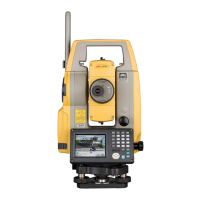
Do you have a question about the Topcon DS Series and is the answer not in the manual?
| Distance Measurement Range (Prism) | 5, 000m |
|---|---|
| Distance Measurement Accuracy (Reflectorless) | +/- (3 + 2 ppm x D) mm |
| Laser Pointer | Yes |
| Display | LCD |
| Communication | USB |
| Category | Total Station |
| Type | Total Station |
| Operating Temperature | -20°C to +50°C |
Identifies and describes the physical components of the instrument and their functions.
Explains the different operational modes of the instrument and navigation between them.
Details fundamental operations of the instrument's keys and display interface.
Explains how to use the on-screen input panel for character and numerical entry.
Describes the Starkey mode interface for quick access to settings and functions.
Provides instructions and precautions for charging the instrument's battery.
Details the procedure for accurately centering the instrument over a survey point.
Explains the initial setup and calibration process for the instrument's touch panel.
Covers setting up and performing communication via Bluetooth wireless technology.
Explains how to connect the instrument to a computer using a USB cable for data transfer.
Configures settings for the automatic target acquisition and tracking functions.
Guides on measuring the horizontal angle between two defined points (Horizontal Angle 0°).
Describes checking the strength of the reflected signal for accurate distance measurements.
Details how to input essential data like station coordinates and instrument height.
Explains how to determine instrument station coordinates using known points.
Guides on setting out points based on horizontal angle and distance from the instrument.
Details how to find an offset point by measuring a single distance.
Explains measuring distances and angles between multiple points without moving the instrument.
Allows adjustment of various parameters affecting data observation and measurement.
Explains how to assign specific functions to the instrument's softkeys for personalized operation.
Explains how to check and adjust the instrument's circular level for proper leveling.
Details the procedure for checking and adjusting the tilt sensor to ensure accurate angle measurements.
Explains how to check and adjust the image sensor alignment with the telescope reticle.
Explains how to achieve higher accuracy sighting with a 360° Prism.
Provides targets for checking the alignment of the instrument's built-in camera.